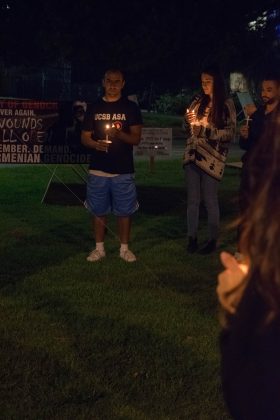
Naima Sudjian Carlisle
The Armenian Student Association (ASA) held a candle-lit vigil to commemorate the 103rd anniversary of the Armenian Genocide at 8 p.m. on Monday, April 23. Armenians and non-Armenians gathered beneath Storke Tower to attend the ceremony.
The official memorial that commemorates the victims of the Armenian Genocide (massacre in Armenian is ‘Meds Yeghern’), is called the Tsitsernakaberd. It was built in Armenia in 1967 and was replicated and constructed five years ago by members of the ASA. The replica of the Tsitsernakaberd is on the grass beneath Storke Tower along with the bold red, blue, and orange colors of the Armenian flag.
“I think it’s important we continue embracing our identity as Armenians,” said Vanasis Ohanian, a fourth year global studies major and president of the Armenian Student Association, on the night of the vigil.
Ohanian also recognized non-Armenian participants, “I thank people for coming and understanding our struggle.”
Under the night sky, everyone in attendance gathered around the memorial in a circle, with the light of their candles glowing upon their faces. Everyone took a long moment of silence before sharing stories, thoughts, and words of inspiration.
One hundred and three years ago on April 24 marked the beginning of the Armenian Genocide that lasted from years 1915-1923 during World War I. Initially, violence erupted when members of the Ottoman Empire arrested and killed several hundred Armenian intellectuals and prominent public figures.
The events after horrified onlookers. Women and children marched in the Syrian desert to concentration camps; many died from exhaustion, dehydration, starvation, and abuse. Ottoman Greeks and Assyrians were among other groups persecuted during the genocide. This point in history forced a global diaspora and resulted in the death of up to 1.5 million people.
Turkey and the United States have not officially recognized the massacre, but 28 countries have to date. A country’s government officially recognizes the genocide by passing a resolution or bill. In countries like Cyprus, Italy, Greece, France, and Switzerland, denial of the genocide is criminalized.
Some people came to the vigil in solidarity, sharing their sympathies and recognition of the genocide. After a moment of silence, one person expressed the importance to stay strong and move forward despite this lack of recognition. They further advised to abstain from hating the Turkish people just because of their ethnicity.
“Time and time again, we see how politics have been placed above humanity,” said Ohanian in regards to some countries neglecting to recognize the genocide.
As a direct response to the failure of recognizing the genocide, ASA members demonstrated the ‘Stain of Denial’ and wore red tape across their mouths on Tuesday from 11 to 2 p.m. The stain of denial symbolizes the bloodshed of Armenians, and the red tape across the mouth symbolizes Turkey’s choice to deny a violent past.
While living with the painful history of suffering, members of the Armenian Student Association strive to stay strong, cultivate community, and bring attention to the Armenian Genocide on UCSB’s campus. In a resolution held on April 24, the Associated Student Senate unanimously voted to recognize the Armenian Genocide. The resolution was a nod to the Armenian Student Association’s dedication to commemorate its history.












